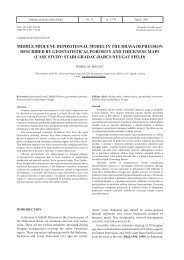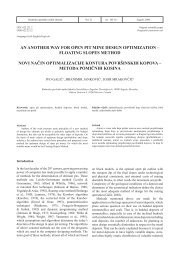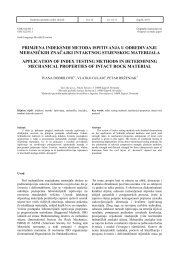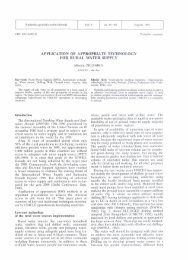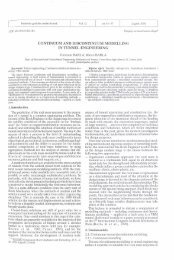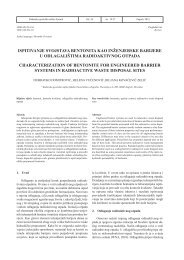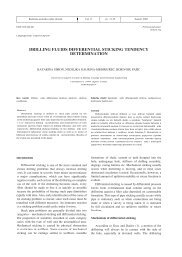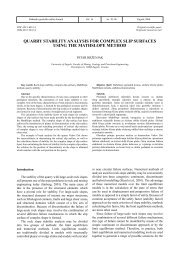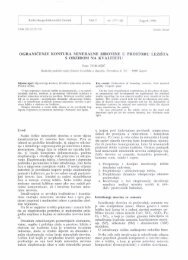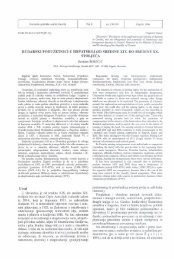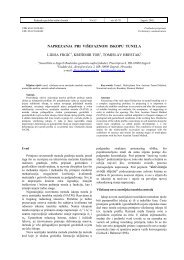TENSILE STRENGTH OF STEEL ROPES OF DIAMOND WIRE SAWS
TENSILE STRENGTH OF STEEL ROPES OF DIAMOND WIRE SAWS
TENSILE STRENGTH OF STEEL ROPES OF DIAMOND WIRE SAWS
- No tags were found...
Create successful ePaper yourself
Turn your PDF publications into a flip-book with our unique Google optimized e-Paper software.
Rud.-geo1.-naR. zb., Vol. 13, Zagreb. 2001Dunda, S. & Ku]undicC, T. Diamond wire sawsin the cut and passes along its bended and rectilinear parts,while the other part is outside the cut and passes along thedriving pulley and positioning pulleys. The rope is constantlystressed also on bending, which causes deteriorationof material and breaking of wires. The rope is not indirect contact with these planes, so the forces are transferredto it via beads by means of surface wire layer in onlyone part of the circumference (Fig. 1). Thanks to the frictionbetween the wires the force is transferred and distributedon the other wires of the rope. This also means thatthe wire contacts rub, deteriorate and decrease the metalcrosssection. Upon bending of diamond wire in the cut (especiallywhen the cut dimensions are small) of the drivingpulley or pulleys, the surface wires of the rope must belengthened (Fig. 2), which means again that the parts ofone wire will move relatively in relation to the wire standingnearby, with which this wire is in contact (pointwise orlinear). After passing over the curve the lengthened part ofthe rope is "coming back" and wires are again moving relativelyin relation to one another, rubbing and deteriorating.The crossing of the wires in the specific strand or thecrossing of surface wires in the nearby standing strands areespecially unfavourable. Crushing appears on such a (pointwise)contact, which in combination with relative movementand rubbing causes intensive local deterioration i.e.decrease of the cross-section.The testings of the deteriorated ropes have pointed tothe causes of decrease of tensile, torsion and bendingstrengths. The main cause of wire deterioration appearedto be corrosion, rubbing and crushing of the rope. Theseare also the places of the reduced wire resistance. It wasdetermined that the wire joints are especially sensitive elementsof diamond wire. The sudden changes of tensilestrengths and the sudden repeated axial impacts, whichappear upon the start-up of the saw after the break, havethe highest effect on the links of the particular rope sections.These are therefore critical areas especially when thesawing angles are more acute. In order to find out if thereis and how much is the difference between breaking loadof the rope and braking load of the joint on the rope weconducted additional laboratory testings, the results ofwhich are presented in this paper.Testings offhe breaking load of the rope aadjointsThe former testings comprised testing of various typesand constructions of ropes, which are used to form a diamondwire. In the meantime most of the users in Croatiahave accepted the round strand rope as the most useful one(Fig. 3) with constructions (1+6+12)+6(1+6). This ropeconstruction proved as the best one in former testings too.Therefore, these testings comprised determination of breakingload of the rope of this construction and breaking loadof the same ropes connected by two kinds of joints. Theropes made by 4 manufacturers were tested and sleeve couplingsand joints with amale-female" threads wereused forconnecting. Connecting was done on a standard devicewhich is used upon shaping of diamond wire (diamond wirebench assembling unit) by the workers of particular usersin the way as they do it for their everyday use. Although allthe ropes had the same bacis construction they differedamong each other to a certain extent in the strength of steeland minor construction details.Fig. 2. Passing of the rope along the curvatureS 2. Prijelaz &eta preko zakrivljenjaThe elasticity of the rope must be extremely high, becausethe entire diamond wire must be extremely elastic.The hardness of the entire wire is increased by its shaping,i.e. putting of diamond beads, strings, rings and spacers.The elements which are threaded on the rope are free andare turning around the rope, which is facilitated by the bendingof some rope parts upon operation, which requires torsionstrength of the rope.Experimental workIn the company Jadrankamen-PuCiSCa (the island ofBraE) the consumption of different rope types was observedin order to determine the characteristics of diamond wirerope and changes of these characteristics after the operationwithin a certain period of time. The observed ropeswere tested in the laboratory after samples were taken fromthe new ropes and the same ropes after particular ones hadto be replaced due to deterioration. After a detailed visualexaminations the testings of breaking strength, bending andtwisting of the rope were also conducted. The results ofthese testings were presented at the 10th International Conference:Investigation, Production and Use of Steel WireRopes - Slowakia, 1998. (D u n d a, 1998).Fig. 3. Cross-section of the tested ropesSI 3 Presjek ispitivanih &etaIn these testings the real breaking load was only determinedby breaking of the rope as a whole, in difference tothe earlier testings, when this load was determined by tesfingof specific wire samples and summing up their values.Upon the testing of the rope by its breaking as a wholeappears gradual breaking of some wires within specificforce and loosening of the strength (Fig. 4). The indicatorof the testing instruments registers the load which causesthe damages of some wires, not the rope braking. This loadis regarded as relevant for determination of the allowedtensile strengths.



